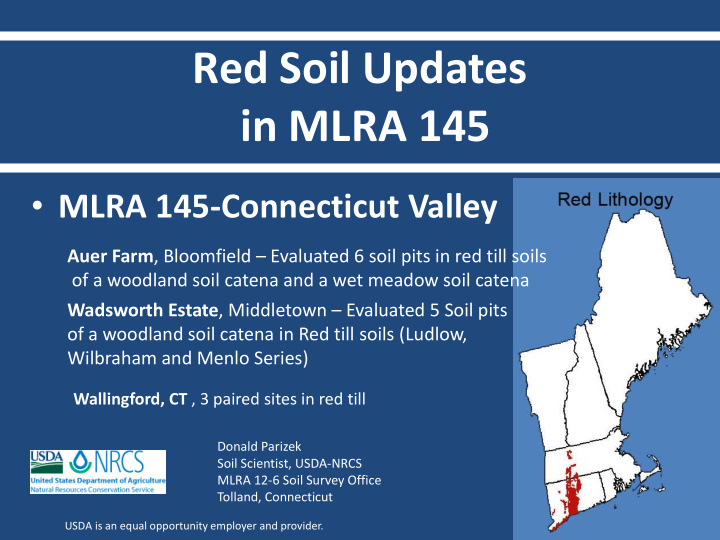



Red Soil Updates in MLRA 145 • MLRA 145-Connecticut Valley Auer Farm , Bloomfield – Evaluated 6 soil pits in red till soils of a woodland soil catena and a wet meadow soil catena Wadsworth Estate , Middletown – Evaluated 5 Soil pits of a woodland soil catena in Red till soils (Ludlow, Wilbraham and Menlo Series) Wallingford, CT , 3 paired sites in red till Donald Parizek Soil Scientist, USDA-NRCS MLRA 12-6 Soil Survey Office Tolland, Connecticut USDA is an equal opportunity employer and provider.
M Wadsworth Estate Auer Farm Wallingford
Problematic Red Soils • Color Change Propensity Index (CCPI) • A value of 30 or less is problematic (Rabenhorst and Parikh, 2000) • Auer Farm Bw Horizon CCPI = 21.71 • Auer Farm C Horizon CCPI = 17.08 • Wadsworth Estate Bw CCPI = 18.37 • Veterans Park Bw1 CCPI = 14.43 • Cooke Road Bw1 CCPI = 16.90
Poorly Drained Wilbraham Soil
Redox in a Red Soil
IRIS TUBES URI Graduate Student Eric Ford installing IRIS Tubes in Wallingford, CT
Data collected, analyzed and compiled by Eric Ford
Wallingford, CT Hydrology Table 3a. Water table summary for each transect point in both 2012 and 2013. The HSTS requires that a water table be within 25 cm of the soil surface during a period of normal or drier than normal precipitation conditions. All periods listed fall within the growing season (based on site soil temperature data). Precipitation condition was based on the Direct Antecedent Rainfall Evaluation Method (WETS Station: ANSONIA 1NE CT0128; Precipitation data: Meriden-Markham Municipal Airport, Meriden, CT). Consecutive Days Within 25 cm† Month(s) Precipitation Condition Site 2012 2013 2012 2013 2012 2013 Veteran’s Field (W)‡ 12 6 November April Drier Drier Veteran’s Field (U) 8 6 November April Drier Normal Cooke Road (W) 18 0 May - Drier - Cooke Road (U) 0 0 - - - - Tyler Mill (W) 40 12 Oct./Nov. Apr./May Normal/Drier Drier Tyler Mill (U) 28 0 November - Drier - † In some cases, a site had more than one period of 14 consecutive days. Only the longest period in a given growing season that meets antecedent precipitation requirements are shown. ‡ Site does not meet the requirements of the HSTS. Data collected with assistance from Tom Pietras analyzed and compiled by Eric Ford, URI
National Hydric Soil Indicator F21: Red Parent Material Indicator F21: Red Parent Material • Technical Description: A layer derived from red parent materials (see • glossary) that is at least 10 cm (4 inches) thick, starting within 25 cm (10 inches) of the soil surface with a hue of 7.5YR or redder. The matrix has a value and chroma greater than 2 and less than or equal to 4. The layer must contain 10 percent or more depletions and/or distinct or prominent redox concentrations occurring as soft masses or pore linings. Redox depletions should differ in color by having: value one or more higher and chroma one or more lower than the matrix, • or value of 4 or more and chroma of 2 or less. • Applicable Subregions: For use with problem soils throughout the • Northcentral and Northeast Region.
F21- User Notes User Notes: This indicator was developed for use in areas of red parent material. • In order to confirm that it is appropriate to apply this indicator to particular soils, soils formed from similar parent materials in the area should have been evaluated to determine their Color Change Propensity Index (CCPI) and be shown to have CCPI values below 30 (Rabenhorst and Parikh, 2000.) It cannot be assumed that sediment overlying red colored bedrock is derived solely from that bedrock. The total percentage of all redox concentrations and redox depletions must add up to at least 10% to meet the threshold for this indicator. This indicator is typically found at the boundary between hydric and non- hydric • soils. Users that encounter a depleted matrix in the upper part should consider F3- Depleted Matrix. F3 is often found in sites that are anaerobic for a longer period. Users that encounter a dark soil surface (value 3 or less and chroma 2 or less) should consider F6-Redox Dark Surface or F7-Depleted Dark Surface. If the site is in a closed depression subject to ponding users should consider F8-Redox Depressions. See glossary for definition of Red Parent Material.
Estimating Redox Many of our estimates ranged between 2 and 10 % redox
Positive Reaction to alpha, alpha-dipyridyl
What have we learned? • Scrutinize the A horizon very closely for redox • Look for Iron/Manganese concretions (BB’s) with a halo of oxidation • Faint Redox Contrast May be Transient with fluctuations in the watertable (seasonal) and is not interpreted consistently by soil scientists in the field. • There are many hydric/poorly drained soils that fail to meet the 10% threshold for redox.
• Pay close attention to landscape position, surface features and vegetation composition/ morphological adaptations. • The Wilbraham soil truly is an Aquept not an Aquic Dystrudept, series update coming soon • IRIS tubes provide good results if installed properly and are left in long enough during the wet part of the growing season • Choose your soil description site wisely, a few feet can make a big difference • Foot slope hydrology can vary wildly with the seasons and year • When in doubt err on the side of caution, come back during the wet season or seek out a local expert
The End
Recommend
More recommend